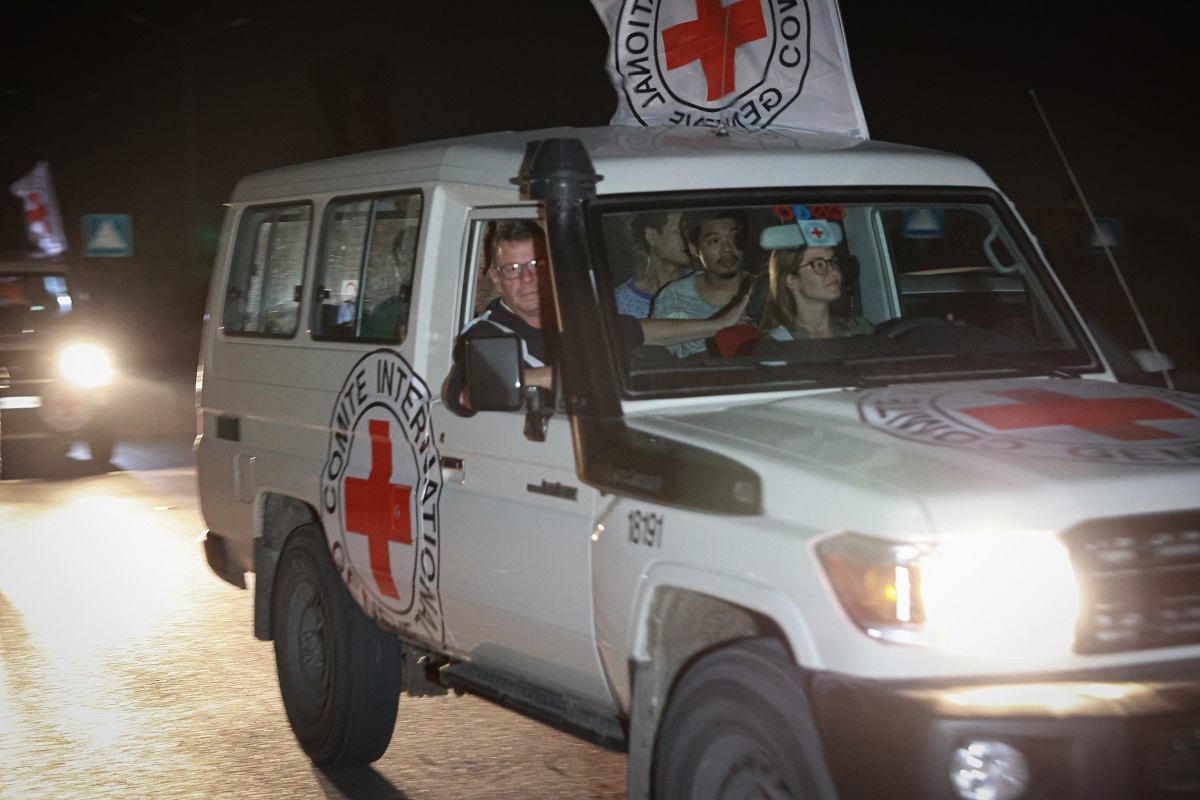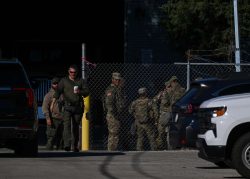
International Red Cross vehicles carrying hostages released by Hamas cross the Rafah border point in the Gaza Strip toward Egypt on Nov. 25.
13:50 JST, February 27, 2024
The Israeli military is confident that Hamas leader Yehiya Sinwar, the alleged architect of the Oct. 7 attacks, is hiding inside a labyrinthine network of tunnels beneath southern Gaza. But he is surrounded by a human shield of hostages intended to deter an operation to capture or kill him, frustrating Israel’s efforts to dismantle the terrorist organization and bring the more than four-month-long war to a close.
The Israeli operation in Gaza cannot conclude until Sinwar is either captured, killed or no longer in a position to run the organization, current and former Israeli officials said in interviews. Underscoring the necessity of eliminating the terrorist leader, and the degree to which the war hinges on that mission’s success, Prime Minister Benjamin Netanyahu told a meeting of his Likud party faction earlier this month, “We will kill the Hamas leadership. … We must not end the war before then.”
But pinpointing Sinwar’s location may not be as difficult, tactically or politically, as mounting a military operation to neutralize him without also killing or injuring many of the hostages believed to be nearby, according to Israeli, U.S. and other Western intelligence and security officials who described the challenging hunt for Israel’s most-wanted man. Many of them spoke on the condition of anonymity to discuss sensitive information and operations.
“It’s not about locating him, it’s about doing something” without risking the lives of the hostages, said one senior Israeli official.
Sinwar is believed to be bunkered in the warren of tunnels beneath Khan Younis, the city in southern Gaza where he was born in 1962 into a family that had been forced out of the Palestinian town of Majdal, now Ashkelon, in the wake of Israel’s 1948 war for independence. U.S. officials said they concur with the Israeli assessment that Sinwar is hiding somewhere underneath his hometown and has surrounded himself with hostages, an ultimate insurance policy.
On Oct. 7, Hamas kidnapped more than 250 civilians and soldiers from Israel and took them into Gaza, officials have said. Hamas has released more than 100 of them. About 130 hostages remain in captivity, an estimate that includes the bodies of about two dozen people who Israeli authorities determined have died. About half a dozen of the remaining hostages are Americans.
For months, the Israeli military and security services have mapped out the vast network of tunnels beneath Gaza in an effort to understand key points in the network and find Sinwar. The painstaking work is done by soldiers working inside the tunnels, who have retrieved information left behind by Hamas fighters that has helped to better understand the interconnected underground system.
As soldiers move through the tunnels, disarming booby traps along the way, they have discovered Hamas administrative files, computers and phone directories that indicate different “offices” in the network, officials said.
Israeli soldiers also have discovered evidence that Sinwar may have been one step ahead of them, Defense Minister Yoav Gallant said in public remarks earlier this month. According to Israeli press reports, soldiers have found Sinwar’s clothes, notes that he wrote by hand and even a toothbrush he may have used.
In recent days, some officials have speculated that Sinwar may have moved a few miles away to Rafah, on the border with Egypt. Israeli officials have publicly disputed press claims that Sinwar escaped over the border.
Paired with interrogations of captured Hamas fighters, the information Israeli forces found underground has helped them further understand the tunnel routes. U.S. intelligence analysts are helping with some of that tunnel mapping, contributing powerful analytic technologies that fuse fragments of information, according to officials with knowledge of the work.
But searching, clearing and closing off the massive network, which some experts believe could be up to 450 miles long, takes significant time and material. Destroying even short lengths of tunnel requires large amounts of explosives. Israeli forces have looked for nodes that, once destroyed, can render other passages running off them effectively inoperative, officials explained.
U.S. intelligence agencies have also assisted in the analysis of intercepted communications and data from recovered computer hard drives as well as information from interrogations, officials said.
That collaboration may help the search for Sinwar. But there are no U.S. intelligence personnel on the ground in Gaza, and the Americans are not assisting Israel in the day-to-day effort of locating and striking rank-and-file Hamas fighters and their facilities, U.S. and Israeli officials said. A former Mossad officer who maintains close ties with the current leadership said the Israelis didn’t need help from the Americans to fight the war.
“The question itself is offensive,” the former officer said.
CIA Director William J. Burns has taken a leading role, along with his Israeli counterpart, Mossad chief David Barnea, in negotiating for the release of hostages. The two agencies have long shared intelligence related to terrorist groups, Iran and other areas of interest to their security.
Negotiations for a six-week pause in fighting and release of civilian hostages are continuing, with Israeli and U.S. officials expressing some optimism. “We’re all working on it,” Netanyahu said Sunday on CBS’s “Face the Nation,” following meetings last week in Paris of negotiators from the United States, Qatar, Egypt and Israel. “We want it, I want it,” he said. “If Hamas goes down from its delusional claims … then we’ll have the progress that we all want.”
Israel has rejected Hamas demands for the release of large numbers of Palestinian prisoners in exchange for hostages, and for at least 500 truckloads of humanitarian aid to enter Gaza daily. After being briefed by its negotiators on the Paris meetings, Israel’s war cabinet agreed Saturday to send a delegation to talks set to begin Monday in Qatar, Israeli media reported.
Public attention on Sinwar’s whereabouts, and his fate, was reignited on Feb. 13, when the Israel Defense Forces released what it said was security camera footage of Sinwar inside a tunnel beneath Khan Younis, the city where officials believe Sinwar is now located. A military spokesman said the video, which the IDF had recently obtained from a Hamas camera, showed Sinwar walking with his wife, children and brother through a darkened passageway on their way to a hiding place, three days after the Hamas attack in October.
The footage offered Israelis a rare, up-close look at the secretive leader’s personal life. And it was another indication that the Israeli military may be closing in on his location.
Whether Sinwar is able to command forces as he holes up underground is a subject of debate. The senior Israeli official said that Sinwar was still making decisions and calling the shots in the war. But recently, Gallant has publicly questioned how much control Sinwar exercises over his forces, given that he is in hiding. “He is not running the military campaign but is engaged in personal survival,” Gallant said in remarks earlier this month.
Some officials, including Gallant, have suggested hostage negotiations have been slow to make progress because of the time it takes to send messages between Hamas’s political leadership outside Israel and Sinwar and his forces in Gaza.
Killing Sinwar would be a huge strategic and symbolic victory for Israel. But some experts question whether eliminating a single leader will bring the government closer to Netanyahu’s stated goal of totally destroying Hamas, which critics say is an ill-defined and unrealistic objective.
“Killing Sinwar would be exercising pure justice. In fact, he deserves to die more than once,” said Alon Pinkas, a veteran Israeli diplomat and former senior-level adviser. “For Israelis he represents evil incarnate, but there should be no doubt: Getting him will not ‘eradicate,’ ‘annihilate’ or ‘topple’ Hamas. Nor would it represent a victory. It would be a justified retribution exacted on one man and it would make Israelis feel there’s justice and a measure of closure. Nothing more, nothing less.”
Many Israeli citizens have criticized Netanyahu for prioritizing the annihilation of Hamas over the return of the remaining hostages. In a remarkable display of division at the highest reaches of the government, Gadi Eisenkot, a member of Israel’s war cabinet and a former chief of staff of the IDF, said last month that the total destruction of Hamas was unrealistic.
Eisenkot acknowledged that Israeli forces had dealt “a major blow” to Hamas and its capabilities in the north of Gaza, where independent experts say more than two-thirds of all structures have probably been damaged or destroyed. But “those who talk about an absolute defeat and lack of will [on the part of Hamas] and ability do not tell the truth,” he told Israel’s Channel 12 News.
Privately, some Israeli officials expressed similar frustration with a goal they see as needlessly absolute. They say that it’s more feasible, and still acceptable, to degrade Hamas as a military organization – killing its leaders, along with a sufficient number of fighters, so that it could never again mount an attack of the scale of Oct. 7.
Israeli and U.S. officials have offered differing accounts of how many Hamas fighters Israeli forces have killed and how many brigades have been neutralized. An anticipated operation against the southern city of Rafah, on the border with Egypt, is widely seen as a final push by the Israeli military to destroy Hamas’s remaining organized groups of fighters.
But the fate of Sinwar remains crucial to the outcome of the war, even if the definition of victory changes. Some officials involved in talks about a potential settlement have discussed allowing Sinwar to leave Gaza and go into exile, although it remains unclear whether he would agree and what country, if any, would be willing to accept him, said one Arab official.
Another former Mossad officer, also still in close touch with his colleagues, argued that killing Sinwar and his lieutenants was important, but only one piece of a broader requirement to destroy Hamas’s military capability, for which an assault on Rafah is essential.
Removing Sinwar will not end the war, but it could hasten Hamas’s demise, said one person close to senior Israeli leadership.
“It would, we estimate, encourage more Gazans to speak out and take on responsibility without Hamas,” this person said. “And it would sever vital ties between Hamas and its international network. We know of course someone else would step into his shoes, but it would either lead to a split or a tremendously weakened Hamas.”
Many Israelis might call that a win.
"News Services" POPULAR ARTICLE
-

American Playwright Jeremy O. Harris Arrested in Japan on Alleged Drug Smuggling
-

Japan’s Nikkei Stock Average as JGB Yields, Yen Rise on Rate-Hike Bets
-

Japan’s Nikkei Stock Average Licks Wounds after Selloff Sparked by BOJ Hike Bets (UPDATE 1)
-

Japan’s Nikkei Stock Average Buoyed by Stable Yen; SoftBank’s Slide Caps Gains (UPDATE 1)
-

Japanese Bond Yields Zoom, Stocks Slide as Rate Hike Looms
JN ACCESS RANKING
-

Tokyo Economic Security Forum to Hold Inaugural Meeting Amid Tense Global Environment
-

Keidanren Chairman Yoshinobu Tsutsui Visits Kashiwazaki-Kariwa Nuclear Power Plant; Inspects New Emergency Safety System
-

Imports of Rare Earths from China Facing Delays, May Be Caused by Deterioration of Japan-China Relations
-

University of Tokyo Professor Discusses Japanese Economic Security in Interview Ahead of Forum
-

Japan Pulls out of Vietnam Nuclear Project, Complicating Hanoi’s Power Plans
























